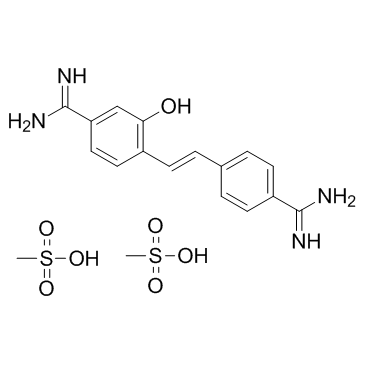Hydroxystilbamidine bis(methanesulfonate) |
| Catalog No.GC32195 |
Se ha descubierto que el bis(metanosulfonato) de hidroxiestilbamidina, un colorante capaz de unirse tanto al ADN como al ARN, es un potente inhibidor de las ribonucleasas celulares.
Products are for research use only. Not for human use. We do not sell to patients.

Cas No.: 223769-64-0
Sample solution is provided at 25 µL, 10mM.
Hydroxystilbamidine bis(methanesulfonate), a dye capable of binding to both DNA and RNA, has been found to be a powerful inhibitor of cellular ribonucleases.
It is found that the trypanocidal dye Hydroxystilbamidine bis(methanesulfonate) permits the recovery of mRNA after polysome released with Nonidet P-40 (NP-40). Sucrose gradient analysis of detergent-lysed postnuclear supernates is used to analyze the size distribution of NP-40-released polysomes. The heparin gradient shows some polyribosomes, whereas the Hydroxystilbamidine bis(methanesulfonate) gradient shows a remarkably large peak of very heavy polyribosomes. This peak is obtained reproducibly if Hydroxystilbamidine bis(methanesulfonate) is present before the addition of NP-40[1].
Hydroxystilbamidine bis(methanesulfonate) is an effective suppressor of the plaque-forming cell (PFC) response when given before sheep erythrocytes (SRBC) stimulation. Hydroxystilbamidine bis(methanesulfonate) depresses the plaque response of the treated mice. Fewer PFC are observed in Hydroxystilbamidine bis(methanesulfonate)-treated mice throughout the experiment, but the level of suppression decreases with time. By day 14, the number of PFC observed in both the Hydroxystilbamidine bis(methanesulfonate) treated mice and the control group is essentially at the background level[2].
[1]. Lizardi PM. Isolation of giant silk fibroin polysomes and fibroin mRNP particles using a novel ribonuclease inhibitor, hydroxystilbamidine. J Cell Biol. 1980 Oct;87(1):292-6. [2]. Folds JD, et al. Immunosuppression by hydroxystilbamidine isethionate, a lysosome-stabilizing, anti-proteolytic, antifungal drug. Infect Immun. 1975 Mar;11(3):441-4.
Average Rating: 5 (Based on Reviews and 5 reference(s) in Google Scholar.)
GLPBIO products are for RESEARCH USE ONLY. Please make sure your review or question is research based.
Required fields are marked with *




















